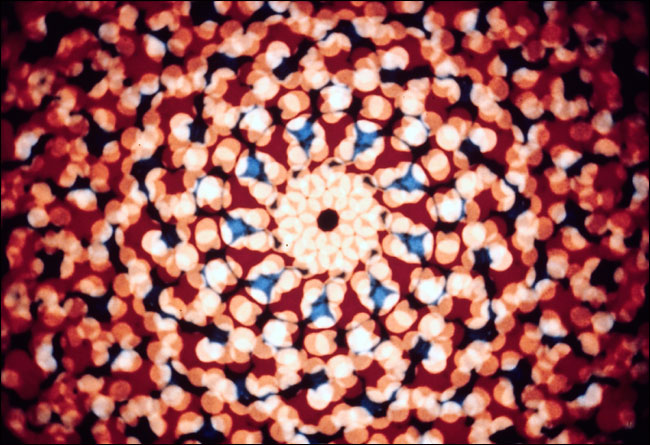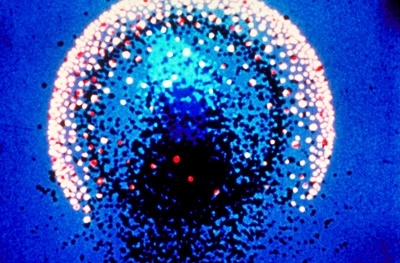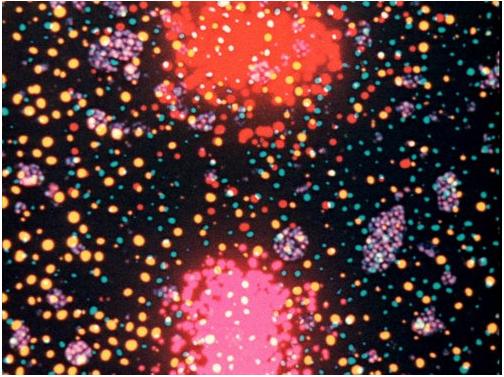
| Les frères James et John Whitney sont deux cinéastes américains.
Leurs premiers films, réalisés dans les années 40, (Twenty Four Variations on an Original Theme, Variations on a Circle, Film Exercises) se situent dans la lignée du cinéma d'animation d'avant-garde tel qu'il s'est développé
au début des années 20 en Allemagne. A partir des années 50, les frères Whitney réalisent des films qui, tout en continuant d'explorer les possibilités offertes par les technologies de leur époque, témoignent de l'influence qu'eurent sur leur génération l'iconographie, la musique et les philosophies traditionnelles orientales, principalement indienne. Entre 1950 et 1957, James Whithney réalise "à la main" l'époustouflant Yantra, Il profite par la suite de l'ordinateur analogique développé entre temps par son frère (qui sera le premier artiste en résidence chez IBM) pour produire son film suivant, Lapis. films mandala films immersifs et psychédéliques atomisation de la lumière rencontre entre technologies de pointe et représentations archétypiques Jusqu'à sa mort en 1982, James travaillera sur 4 autres films : Dwi Ja (1976), Wu Ming (1970-77), Hsiang Sheng (1977) et Kang Jing Xiang (1982). John Whitney est de son côté généralement considéré comme le père de l'animation réalisée sur ordinateur. Il développe lui-même un ordinateur analogique qui lui permettra de produire des séquences animées qui serviront dans la publicité et les génériques de film. On lui doit par exemple les animations hypnotiques qui figurent dans le générique de Psycho d'Alfred Hitchcock. Son travail se distingue de celui de son frère par une approche plus systématique et théorique. Son ambition de fusionner le visuel et le sonore, exposée dans son livre Digital Harmony (1980), l'amènera durant la dernière période de sa vie à créer ses propres compositions musicales simultanément à ses images de film. |
   Photogrammes extraits de Yantra |
| James Whitney was born in 1921, in Pasadena, California, and lived all his life in the Los Angeles area. He studied painting, and travelled in England before World War II. James completed seven short films over four decades and collaborated with his brother John for some of his film work. The first of the brothers' films was “Twenty-Four Variations on an Original Theme”. Its structure was influenced by Schoenberg's serial principles. James and John created their series of “Five Film Exercises” between 1943 and 1944, for which they won a prize for best sound at the 1949 Brussels Experimental Film Competition. In 1946, the brothers travelled to San Francisco Museum of Art to show their films at the first of ten annual "Art in Cinema" festivals. James spent 3 years working on the 8mm film “Variations on a Circle” (1942), which lasts some 20 minutes. Then, he became more involved in spiritual interests such as Jungian psychology, alchemy, yoga, Tao, and Krishnamurti. These interests heavily influenced his later work. Between 1950 and 1955, “Yantra” was produced entirely by hand. By punching grid patterns in 5" by 7" cards with a pin, James was able to paint through these pinholes onto other 5" x 7" cards, to create images of rich complexity and give the finished work a very dynamic and flowing motion. Analogue computer equipment developed by brother John, allowed James to complete “Lapis” (1965) in two years, when it might have taken seven years otherwise. He drew dot patterns again for this film, but the camera was positioned using computer control, allowing each image to be overlaid from multiple angles. In this piece, smaller circles oscillate in and out in a kaleidoscopic array of colours, accompanied by Indian sitar music. The patterns become hypnotic and trance inducing. The two following films “Dwija” (1973) and “Wu Ming” (1977) intended to form a quartet with the two last ones: “Kang Jing Xiang” and “Li”, which remained incomplete when James died in 1982. |
| Both Jung’s writings on alchemy and the work on transformation symbols in the Mass as well as my own dreams were of considerable insight to me at the time. Yantra was basically a creation myth, an attempt to bring about a unity of cosmic happenings and inner psychic happenings, a bringing together of inner and outer realities. At one time, I considered calling it "A Study in the Process of Individuation," a title of one of Jung’s early works. The sequences in the film are roughly as follows: a descent from the uncreated (Akasha); a slow fade, black to white, increasing in tempo to a single frame flicker of pure light, ushering a lower state of energy form; a central horizontal parting of the top and bottom (parting of heaven and earth), a splitting of the primordial atom; a squared circle mandala; serpentine like particle flow movement into a circumambulation of the center; a fountain like rising kundalini revealing a mandala like turning orb, or vessel (Grail); the gradual involution and emptying process moves back to the beginning and end. The creative vessel, or Grail, is probably the peak of the film. From the vessel the Lapis or the stone will emerge. The circumambulation means the total attention on the center. Eastern lamaistic mandalas usually contain a squared ground plan of the stupa temple. Acccording to ritual, stupas must be circumambulated to the right. Much of this kind of imagery is somewhat fun to go over, although it doesn’t have much, if any, meaning for me now. Then again, bits of imagery like this do come back. For example, Dwija (which I’m working on now) uses the alchemical vessel, but my approach now is totally different. James Whitney – Interview with T. Teramaye, 1974 |
James Whitney (1922-82) Variations on a Circle (1939-43), 9 minutes Five abstract Film Exercises (1944), 10 minutes Yantra (1950-55), 5 minutes Lapis (1963-66), 10 minutes Dwi Ja (1976), 17 minutes Wu Ming (1970-77), 17 minutes Hsiang Sheng (1977) Kang Jing Xiang (1982), 13 minutes |
|
Loading the player ...
|
Loading the player ...
|
| James Whitney, Yantra,
1950-1957 film 16mm, 7', couleur, sonore ( Les images de ce film ont été synchronisées a posteriori sur la musique de Caïn et Abel du compositeur néerlendais Henk Bading.) Un «yantra» est un outil - de la grande machine cosmique à une petite roue de prière - qui favorise la méditation et les visions intérieures qui conduisent à la réalisation du «Moi» universel. YANTRA a été réalisé en perforant des trous sur des cartes au moyen d'une aiguille ; les structures de base des trous furent filmées en utilisant une tireuse optique afin d'introduire la couleur, le clignotement, etc... Sept ans furent nécessaires à la réalisation du film. "Yantra est à la base un mythe de création, une tentative d'apporter une unité aux événements cosmiques et aux événements psychiques intérieurs, l'union entre des réalités externes et internes. " |
James Whitney, Lapis,
1963-1966 film 16mm, 9', couleur, sonore James WHITNEY’s Lapis (1966) is a classic work of abstract cinema, a 10-minute animation that took three years to create using primitive computer equipment. In this piece smaller circles oscillate in and out in an array of colors resembling a kaleidoscope while being accompanied with Indian sitar music. The patterns become hypnotic and trance inducing. This work clearly correlates the auditory and the visual and is a wonderful example of the concept of synaesthesia. |
|
Loading the player ...
|
Loading the player ...
|
| John Whitney, Permutations, 1968 film 16mm, 8', couleur, sonore (sur une musique de Balachandra au tabla) |
John Whitney, Arabesque,
1975 film 8', couleur, sonore (sur une musique de Manoocheler Sadeghi) |
|
Loading the player ...
|
| John Whitney, Experiments in motion graphics, 1968 "John H. Whitney explains the graphic art potential of the computer and the methods and philosophy involved in his computer film making. Filmed at the Health Sciences Computing Facility of the School of Medicine at UCLA." [source] |